The Razer Edge Review
by Vivek Gowri on March 28, 2013 11:00 AM EST- Posted in
- Tablets
- Mobile
- Razer
- Razer Edge
Performance
Now for the good parts. We’re actually pretty familiar with the computing platform behind the Edge. The ultra-low voltage IVB parts are commonly found in ultrabooks and are some of the AT mobile team’s favorite mobile processors right now. I’m not the only one, Dustin just rhapsodized about the ULV Core i5s in his review of the updated Dell XPS 13 last week. The usable performance and reasonable power draw on offer are just that fantastic, and these CPUs really represent the sweet spot of the market right now. I’m not sure that the additional CPU headroom of the i7s is really necessary or worth the additional cost; the 100-200MHz clock speed bumps are pretty incremental. The only really compelling thing about the i7 SKUs is their ability to hit 3.0-3.1GHz on Turbo, a solid 400MHz higher than the corresponding i5 parts.
The other thing is that I’m seeing a lot of cases where there will be two SKUs on offer – one with an i5, 4GB RAM, and a 64GB/128GB SSD, and then a high end one that offers spec bumps across the board – i7, 8GB, and 128GB/256GB. We’re moving away from the early 2000s Dell/HP/Gateway-era of pick your component computing, so the decision between i5 and i7 chips might actually be hinge on the rest of the package, as is the case with the Edge.
Anyways, that’s diverging a bit. We’re very familiar with both of the CPUs used by the Edge from various ultrabooks; in particular, the i5-3317U is the heart of my trusty ASUS Zenbook Prime and I just recently looked at the i7-3517U in my review of the Vizio CT15. The i7-3517U has a base clock speed of 1.9GHz and a max turbo of 3.0GHz, along with HD 4000 onboard graphics (350MHz base clock, 1.15GHz max). It performs roughly where we’d expect, and I’d also like to highlight the relative lack of differences between the i5 and i7 ULV SKUs here.
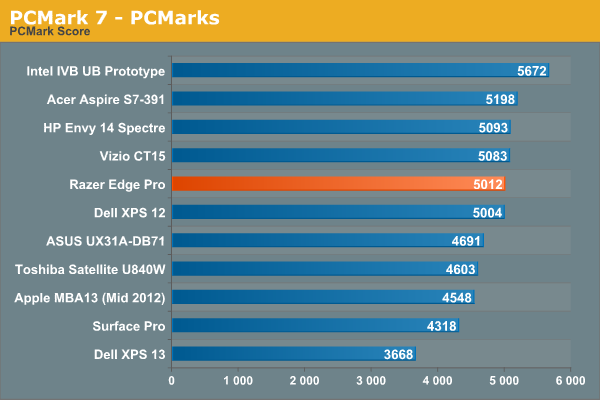
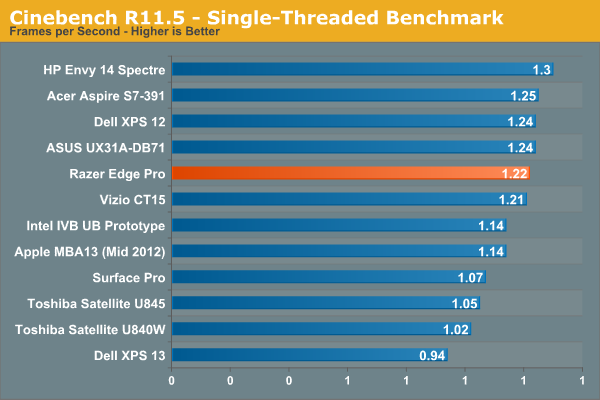
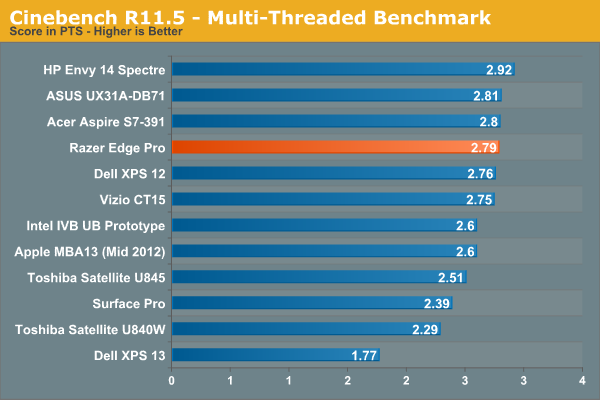
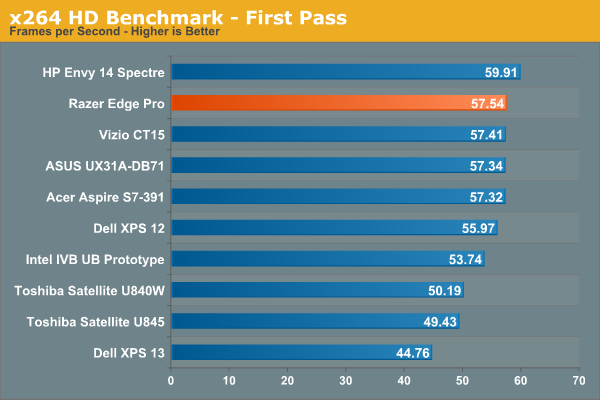
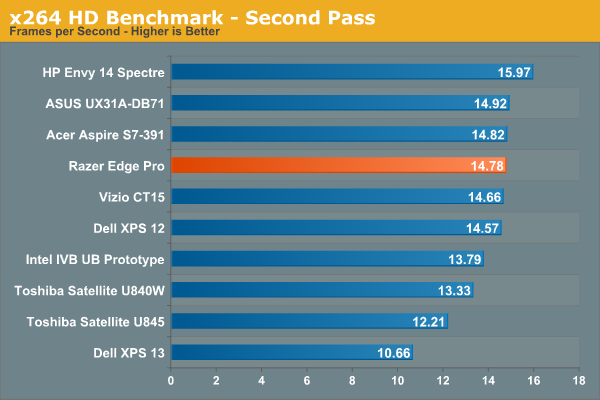

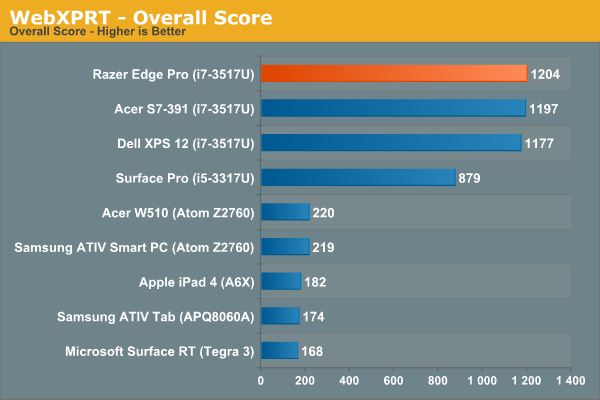
Graphics Performance
Nvidia’s mobile GPU heirarchy can get very, very convoluted, particularly at the low end, with a mix of new, old, and gap-bridging parts all under the same name. As such, there are many variants of GT 640M and GT 640M LE, with a mix of SKUs spanning the 28nm Kepler, 40nm Fermi, and 28nm die-shrunken Fermi cores. An interesting and related side-note: a few days ago, Anand asked the mobile team if we had seen any Kepler-based GT 630M notebooks. It took a bit of searching, but eventually it was determined that none of the GT 630M SKUs are actually Kepler based, only 28nm and 40nm variants of the Fermi core. When the lineups are so jumbled that even we can’t keep track of them, there’s something wrong. Why are some GT 640Ms so slow, while others are nearly equal to the DDR3 GT 650M? Why are there still 40nm GeForce 600M parts? I wish Nvidia could simplify and streamline their mobile GPU lineup, it’d make our lives easier as well as being a lot more transparent for consumers.
The GT 640M LE in the Edge is thankfully a Kepler part, so a 28nm GK107 core with 384 cores, 16 ROPs, and 32 TMUs, just like all Keplers from the GTX 660M on down. This is the absolute bottom of the range, so it has the slowest memory configuration (900MHz DDR3) and a 500MHz core clock, with boost up to 570MHz. The next big hardware jump comes with GDDR5 VRAM in the GT 650M, and a combination of clock speeds and GPU boost make up the differences between SKUs.
The 1366x768 panel comes into play here – Kepler, even at 500MHz, is more than capable of pushing 768p displays at high settings in modern games. High quality textures really start to tax the slower memory in the low-end Kepler cards as you increase resolution, so even with higher clock speeds, 1080p gaming will be non-ideal at best and downright bad at worst. Don’t expect much to be playable, as even the DDR3 variant of the GT 650M basically failed the 1080p portion of our gaming tests. The GDDR5 GT 650M and the GTX 660M (which comes in GDDR5 form only) do better here, but there’s a pretty substantial gap between those two chips and the rest of the GK107 mobile parts at 1080p.
We haven’t yet finalized our 2013 Gaming test suite, so I just ran our 2012 test suite. I did almost all of my testing on the road, sans access to 1080p displays, so I only have 1366x768 gaming results (that’s our value gaming suite, which runs medium detail settings at 768p). I also ran at high detail settings, to see what kind of differences there would be. Once our new suite is finalized, I’ll update with results at 1600x900 and 1080p.
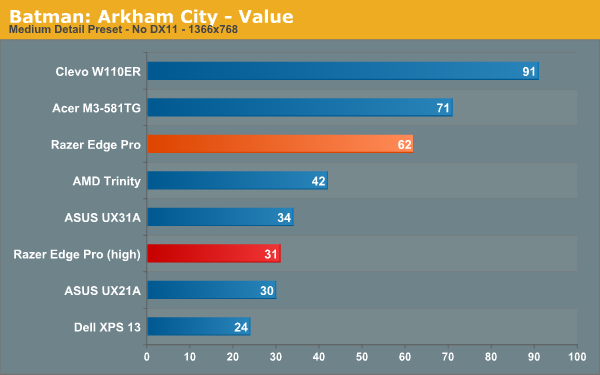
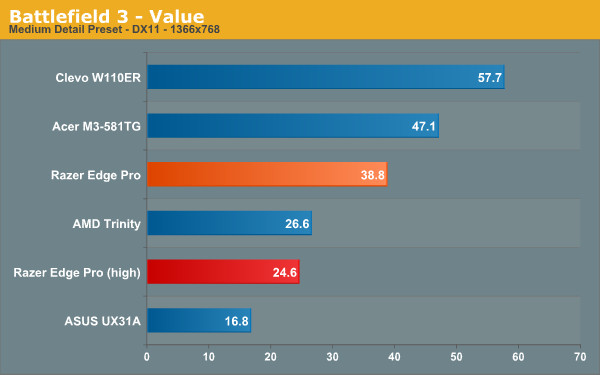
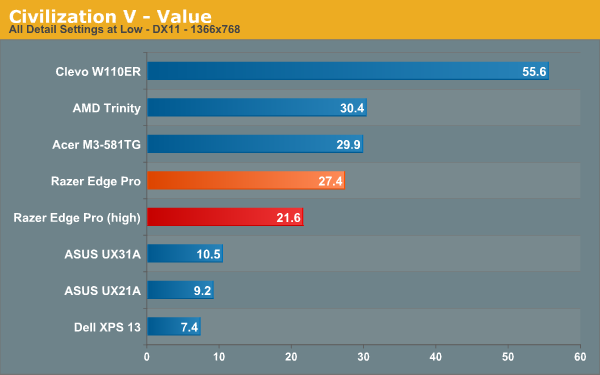
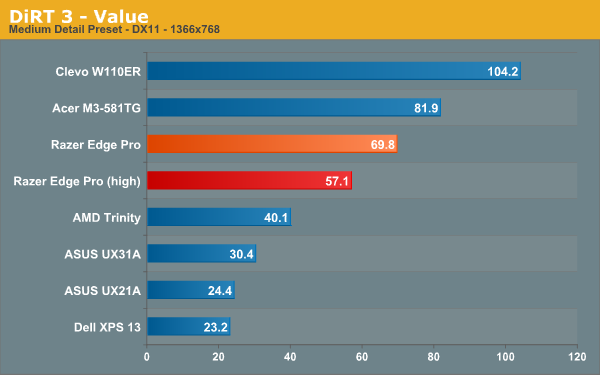

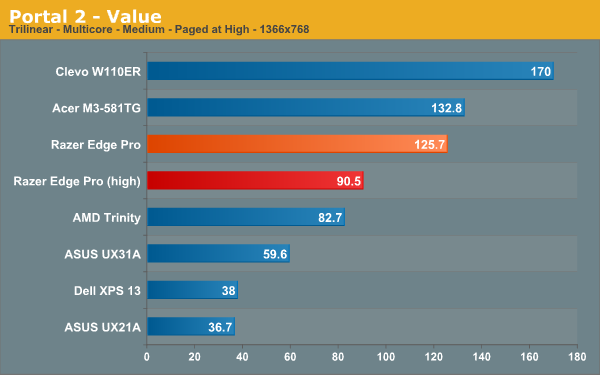
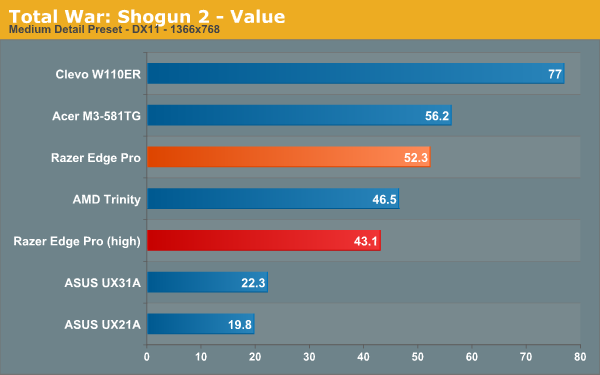
The Edge does pretty well, honestly – Kepler is a great mobile GPU, even clocked so low. At high settings, almost everything was playable, except for Battlefield 3 and Civ 5. I think Civ 5 is CPU limited on the Edge, while BF3 is one of the more strenuous games we test, so both of those were expected. Lower the settings to medium, and pretty much everything is playable.
The higher clock speeds of the GT 650M (DDR3) in the Clevo W110ER really make themselves felt, with substantially better gaming performance than the Edge throughout our benchmark suite. For a comparison with Surface Pro and the other IVB tablets, look at the ASUS Zenbook Primes - the UX31A with the 1.15GHz HD 4000 (i7-3517U) and the UX21A with the same HD 4000 clocked at 1.05GHz (i5-3317U). There's a small performance delta between the two due to the maximum frequency difference, but either way, HD 4000 seriously struggles to be playable in most of our benchmarks unless you lower either the resolution or detail settings. Again, Kepler at 500MHz is still a pretty capable card at 1366x768, so concern over frame rates is probably a moot one unless you’re gaming on an external display.










89 Comments
View All Comments
batteries4ever - Thursday, March 28, 2013 - link
Very nice and actually a few days early.........A tablet of $1299+ that only Arnold Schwarzenegger could comfortably hold for any time with enough power to heat up your room....... just what we were all waiting for!
kyuu - Thursday, March 28, 2013 - link
This is interesting as a proof-of-concept, but ultimately it's just not terribly practical: too big and bulky, too much heat, too little battery power. The tech just isn't there for this to work at this point in time.I think building something like this around a Trinity/Richland solution would yield better results. As seen on the charts, Trinity games well enough at 720p and medium settings.
SmCaudata - Thursday, March 28, 2013 - link
I think this is really the future. With Haswell you could have one PC that does everything.Mobile gaming. Docking to PC setup. Docking to TV. Bring to work with keyboard configuration. And so on...
It seems expensive but 2500 for the only computer you need anywhere really isn't bad.
jamyryals - Thursday, March 28, 2013 - link
I agree with you on price. I wouldn't buy this NOW, but considering this is the first dGPU tablet effort (I think this is true?) there's so much room to improve in the next few years. I guess I really hadn't considered combining an x86 tablet with a GPU hardy enough to do some gaming on as well. I always made the assumption of integrated graphics, and someone was crazy enough to build it. Like Vivek, I'm very much intrigued.flyingpants1 - Friday, March 29, 2013 - link
Literally everything you said can be done with any current laptop. Lenovo Y580 runs BF3 @ 1080p and it's $900.thesavvymage - Thursday, March 28, 2013 - link
damn, just switch it to controller compatibility mode in steam and youre set! So many good games to play that dont need a mouse+keyboard. This is a pretty sweet systemgostan - Thursday, March 28, 2013 - link
heavy, bulky, thick, 2 hours battery life with compromised graphics setting, low res display, noisy and it costs 2000.seriously, why bother?
mayankleoboy1 - Thursday, March 28, 2013 - link
So, would you buy this, or Nvidia Shield ? :PRoninX - Thursday, March 28, 2013 - link
Why not both? I had a chance to play with a Shield at PAX East, and it was a nice unit, but the lack of AAA Android games is a (possibly temporary) downside. There was Shadowgun and the Dead Trigger demo and the promise of Hawken . . . but that was about it.vvk - Thursday, March 28, 2013 - link
"10.1” 1366x768 IPS display""a bit thicker than other tablets at 19.5mm"
"priced at US$1200-$1400"
Stopped reading after seeing the above. A very niche market product.